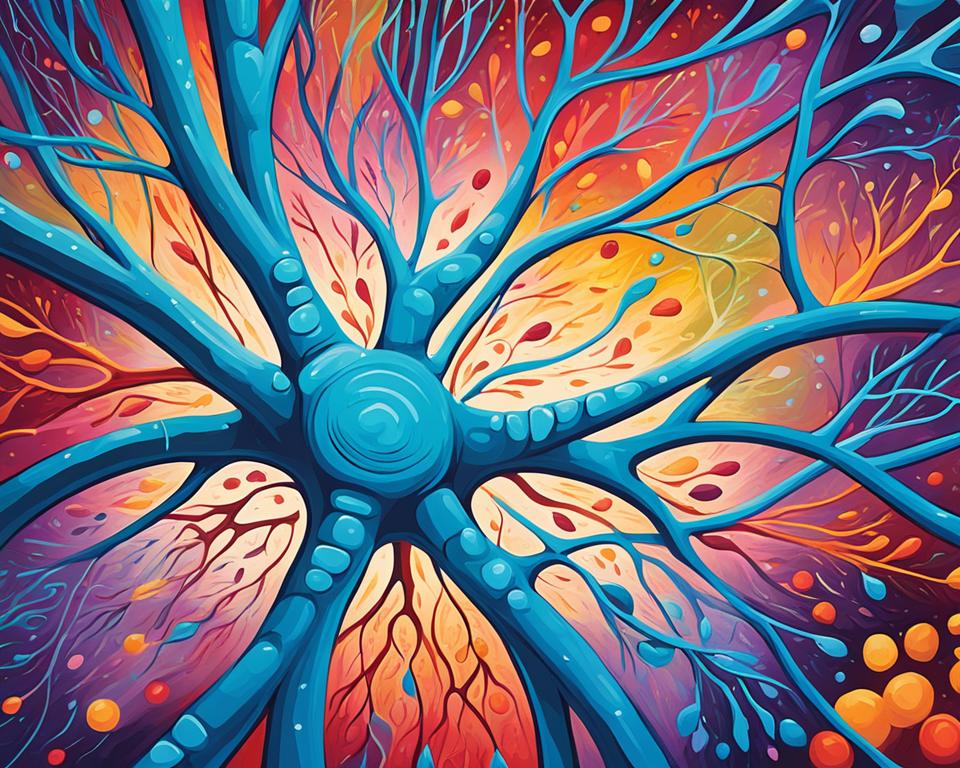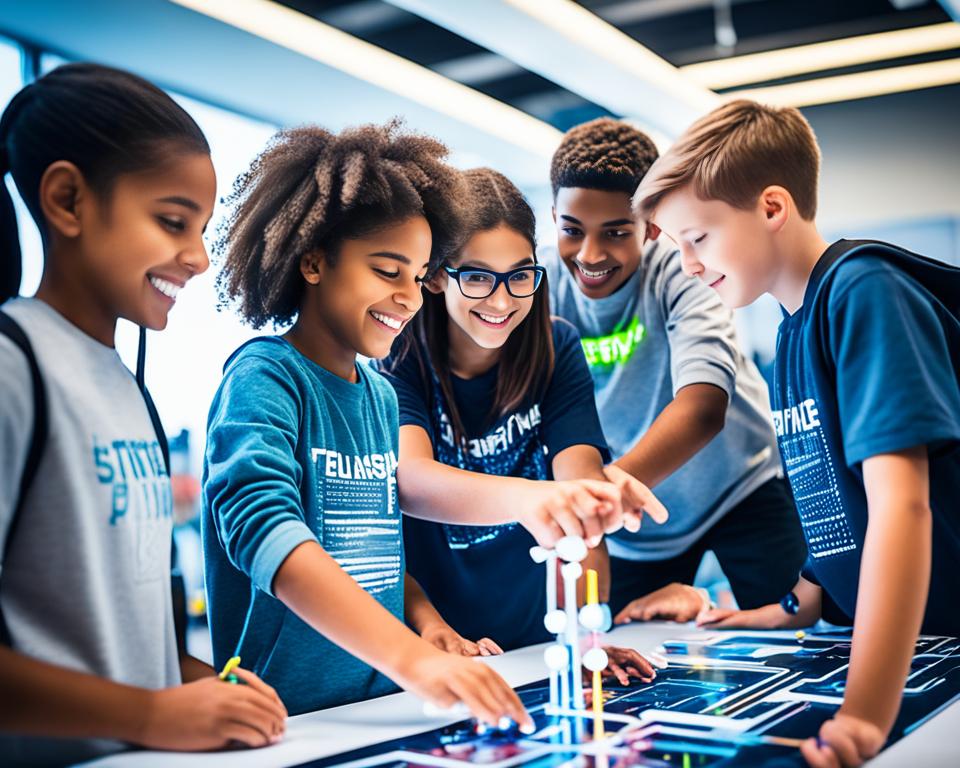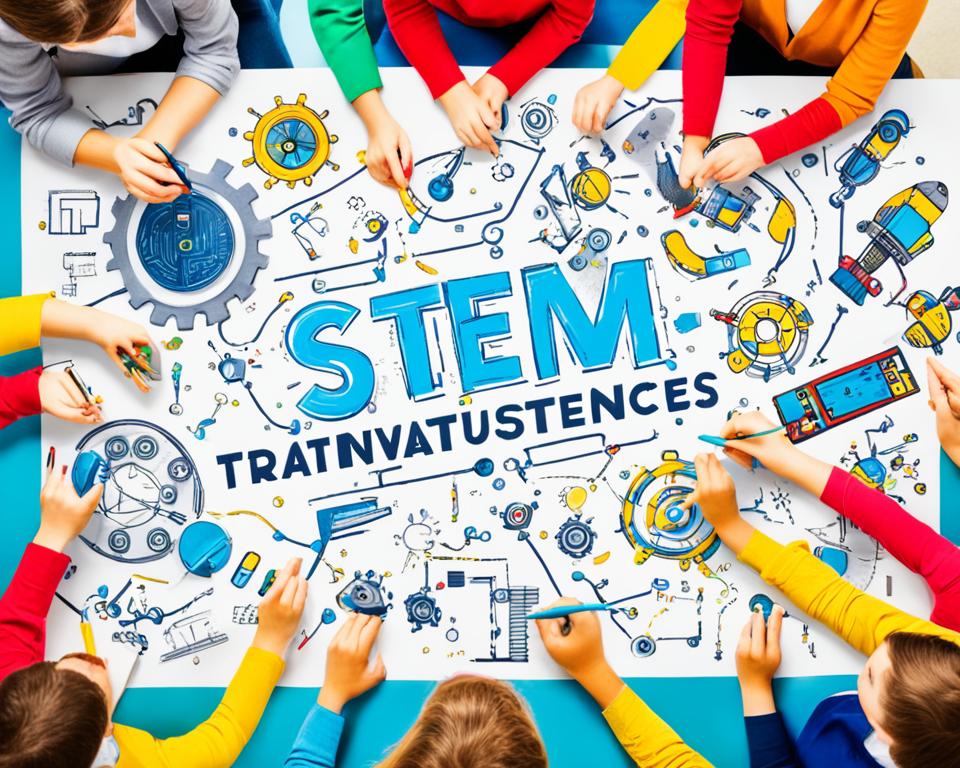As an educator, I firmly believe that creativity is essential for unlocking the full potential of STEM (Science, Technology, Engineering, and Mathematics) education. In an era where innovation and problem-solving skills are in high demand, it is crucial that we explore strategies and examples of how to incorporate creativity into our STEM curricula. This article will delve into the importance of creativity in STEM fields, the benefits of creative education programs, and practical approaches for teachers to foster creativity in their classrooms.
Alongside exploring the neuroscience behind arts education and its impact on learning, I will also provide guidance on assessing creativity and addressing the barriers that can hinder creative STEM learning. Additionally, I will highlight collaborative STEAM (Science, Technology, Engineering, Arts, and Mathematics) initiatives and the digital tools and resources that can support creative STEM education.
Key Takeaways
- Creativity is a vital skill for success in STEM fields, enhancing learning, fostering innovation, and developing essential 21st-century competencies.
- Integrating creative education programs, such as project-based learning, maker education, and arts integration, can cultivate creativity in STEM classrooms.
- Strategies like creating stimulating physical environments, hosting task parties, and embracing mistakes can promote creativity in STEM instruction.
- Neuroscience research demonstrates the powerful impacts of arts education on attention, memory, and higher-order thinking skills.
- Collaborative STEAM initiatives and digital tools can support the integration of creativity in STEM learning.
Importance of Creativity in STEM Education
Creativity is increasingly recognized as a vital skill for the future, as it is essential for STEM fields. The integration of creative education programs and innovative learning approaches can significantly enhance student learning, foster innovation and problem-solving skills, and develop the essential 21st century competencies that are crucial for success in the modern world.
Fostering Innovation and Problem-Solving Skills
Researchers have found that play and experimentation are important for productive thought, and that encouraging students to “play with ideas” can nurture creativity. The article highlights how creativity is a core competency in science and behind many “Eureka!” moments of discovery. By embracing experiential education and project-based learning, educators can create dynamic learning environments that challenge students to think critically, collaborate, and apply their knowledge in innovative ways.
Developing Essential 21st Century Competencies
The integration of arts integration, maker education, and design thinking into STEM curricula can help develop the essential 21st century competencies that students need to thrive in the modern world. These competencies include critical thinking, communication, collaboration, and digital literacy. By fostering a student-centered learning environment that encourages inquiry-based instruction and personalized learning, educators can nurture the creativity and growth mindset that are essential for success in STEM fields.
Creative Education Programs
As we explore strategies for integrating creativity into STEM (Science, Technology, Engineering, and Mathematics) education, it’s essential to examine various creative education programs that can be seamlessly incorporated into STEM curricula. These innovative approaches not only foster creative education programs and innovative learning but also cultivate experiential education, project-based learning, and arts integration – all of which are crucial for developing well-rounded, future-ready students.
Project-Based Learning (PBL)
One such approach that has gained significant traction in STEM education is Project-Based Learning (PBL). This methodology allows students to work on real-world challenges, ask thoughtful questions, think critically, and apply their academic knowledge in creative and meaningful ways. By engaging in PBL, students develop essential student-centered learning and inquiry-based instruction skills, preparing them for the demands of the 21st-century workforce.
Maker Education and Makerspaces
Maker education and makerspaces offer another innovative way to foster creativity in STEM learning. These dynamic environments empower students to think, imagine, and explore ideas through hands-on making, experimenting, and tinkering. By immersing themselves in the design thinking and steam curriculum process, students can tap into their personalized learning and experiential learning abilities, cultivating a deep appreciation for the steam education and digital literacy required for success in the modern world.
Arts Integration in STEM Curricula
Lastly, the article examines the profound benefits of arts integration in STEM curricula. By incorporating movement, dance, theater, and visual arts, educators can effectively model concepts, explain content knowledge, and develop essential project-based curricula and innovative teaching methods skills. This arts integration approach not only fosters creativity but also nurtures a growth mindset and a deeper understanding of STEM principles, preparing students for the challenges and opportunities of the future.

Strategies for Promoting Creativity in the Classroom
Fostering creativity in the STEM classroom requires a multifaceted approach. One key strategy is creating a stimulating physical environment that inspires innovation and collaboration. By designing flexible, inclusive spaces that allow for various arrangements, we can encourage students to engage in creative problem-solving, hands-on experimentation, and open-ended exploration.
Creating a Stimulating Physical Environment
The classroom layout and available resources can have a significant impact on students’ creativity and learning. Incorporating elements such as modular furniture, movable walls, and various work surfaces can enable students to reconfigure the space to suit their needs and preferred learning styles. Additionally, providing access to a wide range of materials, tools, and technology can empower students to tackle challenges in imaginative ways, blending creative education programs, innovative learning, and experiential education.
Task Parties and Open-Ended Challenges
Another effective strategy for promoting creativity in the STEM classroom is hosting “task parties,” where students are presented with a creative challenge to complete within a set timeframe. These open-ended challenges encourage students to think outside the box, tap into their project-based learning skills, and explore innovative arts integration and maker education approaches. By engaging in these dynamic, collaborative activities, students can develop essential design thinking, steam curriculum, and personalized learning competencies.
Ultimately, the key to fostering creativity in the STEM classroom lies in creating an environment that empowers students to experiment, take risks, and find joy in the process of learning. By providing opportunities for hands-on making, inquiry-based instruction, and student-centered learning, educators can nurture the project-based curricula, innovative teaching methods, and experiential learning that are crucial for thriving in the 21st century.
Neuroscience of Arts Education
The integration of the arts into STEM (STEAM) curriculum has profound implications for student learning and development, as revealed by the fascinating field of neuroscience. Numerous studies have shown that arts education can strengthen the brain’s attention system, leading to increased capacities for attention, memory, and learning. This is particularly important in today’s digital age, where constant distractions can hinder students’ ability to focus and retain information.
Enhancing Attention, Memory, and Learning
When students engage in creative activities like music, dance, or visual arts, their brains undergo neuroplastic changes that enhance their cognitive abilities. The arts stimulate the brain’s attention system, which is vital for information processing, memory formation, and overall academic success. By challenging students to observe, interpret, and express themselves through artistic mediums, educators can help them develop stronger attentional capacities and improve their learning outcomes.
Developing Higher-Order Thinking Skills
The neuroscience of arts education also reveals the powerful impact of creative activities on the development of higher-order thinking skills. Engaging in experiential education, project-based learning, and maker education can induce neuroplasticity and result in improved critical thinking, problem-solving, and decision-making abilities. Contrary to the myth that creativity is an innate gift, research has shown that it can be cultivated and strengthened through effective teaching that challenges students to apply their content knowledge in novel and imaginative ways.
By understanding the neuroscience behind the benefits of arts education, educators can make informed decisions about integrating creative education programs, innovative learning strategies, and steam curriculum into their classrooms. This holistic approach to STEM education can have a profound impact on student learning and development, preparing them for the demands of the 21st century.

Modeling and Inspiring Creativity
As educators, we have a profound responsibility to model and inspire creativity in our STEM classrooms. By demonstrating our own creative thinking and problem-solving skills, we can ignite the sparks of innovation in our students. One powerful way to do this is by utilizing a variety of engaging strategies and techniques, such as storytelling, analogies, games, or simulations. These methods not only capture our students’ attention but also encourage them to think beyond the confines of traditional learning.
Furthermore, we can showcase our creativity by adapting our curriculum, instruction, and assessment to cater to the unique needs, interests, and abilities of our students. This personalized approach not only fosters creative education programs and innovative learning but also empowers our students to take ownership of their educational journey. By sharing our own experiential education and creative challenges, we can inspire our students to embrace the joy of learning and to take calculated risks in their project-based learning and arts integration endeavors.
When we model creativity, we send a powerful message to our students: that learning is a dynamic, iterative process, and that the pursuit of knowledge is an adventure to be relished. By nurturing a culture of maker education, design thinking, and steam curriculum, we can cultivate a generation of problem-solvers, innovators, and lifelong learners who are equipped to tackle the complex challenges of the 21st century.
As teachers, our ability to model and inspire creativity is not only a professional imperative but also a personal calling. By embracing our own personalized learning, inquiry-based instruction, and student-centered learning approaches, we can empower our students to develop the project-based curricula, innovative teaching methods, and experiential learning skills that will serve them well in the steam education, maker spaces, and digital literacy landscapes of the future.
In doing so, we not only model creativity but also inspire our students to cultivate a growth mindset that will serve them well in all their future endeavors.
Assessing Creativity in STEM Education
Evaluating creativity in STEM (Science, Technology, Engineering, and Mathematics) education can be a complex and multifaceted endeavor. Traditional assessment methods often fall short in capturing the nuanced and subjective nature of creative thinking. However, educators can employ a variety of strategies to effectively measure and assess students’ creative abilities and achievements.
Rubrics and Portfolios
One effective approach is the use of well-designed rubrics that target specific aspects of creativity, such as originality, flexibility, fluency, and elaboration. These rubrics can be used to evaluate students’ creative thinking processes, the quality of their creative products, and their ability to apply innovative solutions to real-world problems. Complementing rubrics, portfolios offer students the opportunity to showcase their creative work over time, providing a more holistic view of their creative development and growth.
Self-Assessments and Peer Evaluations
Incorporating self-assessments and peer evaluations into the creative learning process empowers students to reflect on their own creative efforts and receive valuable feedback from their peers. This not only encourages self-awareness and metacognition but also fosters a collaborative environment where students can constructively critique each other’s ideas and inspire one another to push the boundaries of their creativity.
By employing a combination of these assessment methods, educators can gain a more comprehensive understanding of their students’ creative abilities, identify areas for growth, and provide targeted support to nurture the development of innovative thinking and problem-solving skills in STEM education.

Overcoming Barriers to Creativity
As educators strive to integrate creativity into STEM education, they must be cognizant of the potential barriers that can hinder this process. One significant obstacle is the presence of “creativity killers” – factors such as excessive surveillance, evaluation, rewards, and external pressure. These elements can inadvertently stifle students’ natural curiosity, risk-taking urges, and intrinsic motivation to explore and innovate.
Avoiding Creativity Killers
To overcome these creativity killers, teachers should create an environment that fosters a sense of autonomy, where students feel empowered to take risks and experiment without the fear of constant evaluation or judgment. Encouraging an atmosphere of openness, collaboration, and constructive feedback can help students feel safe to explore their ideas and embrace the creative process.
Embracing Mistakes and Risk-Taking
Equally important is the need to cultivate a growth mindset within the classroom, where mistakes are viewed as opportunities for learning and growth rather than failures. By helping students understand that creativity and innovation often involve trial and error, teachers can encourage them to embrace risk-taking and view mistakes as stepping stones to success. This mindset shift can unlock students’ potential to think outside the box, problem-solve, and engage in the creative exploration of STEAM (Science, Technology, Engineering, Arts, and Mathematics) concepts.
By addressing these barriers and fostering an environment that celebrates creativity, teachers can empower their students to become innovative thinkers, problem-solvers, and leaders in the STEM fields of the 21st century.
Collaborative Approaches to STEAM
Integrating creativity into STEM (Science, Technology, Engineering, and Mathematics) education can be powerfully amplified through collaborative STEAM (Science, Technology, Engineering, Arts, and Mathematics) initiatives. These interdisciplinary approaches encourage students to apply their knowledge and skills in innovative ways, fostering creativity and problem-solving abilities essential for the 21st century.
Interdisciplinary Projects and Partnerships
One key strategy is to engage students in interdisciplinary projects and partnerships that bring together multiple subject areas. By working on real-world challenges that require the synthesis of diverse knowledge and perspectives, students can develop creative education programs, hone their innovative learning skills, and explore experiential education opportunities. These project-based learning experiences empower students to tackle complex problems through creative and collaborative approaches.
Community Engagement and Real-World Applications
The article also highlights the importance of community engagement and real-world applications in STEAM education. By collaborating with local organizations, businesses, or experts, students can gain practical experience and apply their knowledge to address authentic problems. This not only fosters student-centered learning and inquiry-based instruction, but also inspires creativity, promotes problem-solving, and prepares students for the challenges of the 21st century.

Through these collaborative STEAM initiatives, students can develop a range of innovative teaching methods, engage in experiential learning, and explore maker spaces and steam education opportunities. By embracing the intersection of creativity and STEM, educators can empower students to become digitally literate, adaptable, and equipped with the growth mindset necessary for success in today’s rapidly evolving world.
Digital Tools and Resources for STEAM
The article acknowledges the role of digital tools and resources in supporting creative STEM education. From online simulations and interactive visualizations to coding and programming platforms, technology can enhance student engagement, facilitate personalized learning, and enable collaborative problem-solving. The article highlights various digital tools and resources that can be integrated into STEAM lessons, such as virtual reality experiences, 3D design software, and digital storytelling platforms. By leveraging these digital tools, teachers can create immersive and engaging learning environments that foster creativity, critical thinking, and digital literacy skills.

For example, virtual reality (VR) experiences can transport students into experiential learning environments, allowing them to visualize and interact with STEM concepts in innovative ways. 3D design software, such as SketchUp or Tinkercad, empowers students to bring their creative ideas to life through hands-on making and design thinking. Additionally, digital storytelling platforms, like Adobe Spark or Book Creator, enable students to communicate their project-based learning experiences through engaging multimedia presentations.
By integrating these digital tools and resources into STEAM curricula, educators can foster a student-centered learning environment that encourages inquiry-based instruction, personalized learning, and the development of essential 21st century competencies, such as creativity, collaboration, and digital literacy. Ultimately, the strategic use of technology in STEAM education can unlock new possibilities for innovative teaching methods and experiential learning, empowering students to become creative problem-solvers and lifelong learners.
Conclusion
In conclusion, this article has explored the vital importance of integrating creativity into STEM (Science, Technology, Engineering, and Mathematics) education. By highlighting the benefits of creative education programs, such as project-based learning, maker education, and arts integration, we have demonstrated how these approaches can foster innovation, problem-solving skills, and the essential competencies needed for success in the 21st century.
Additionally, we have delved into the strategies for promoting creativity in the classroom, including creating stimulating physical environments, hosting task parties and open-ended challenges, and empowering teachers to model and inspire creativity through their own teaching practices. The neuroscience behind arts education has also been examined, revealing how it can enhance attention, memory, and higher-order thinking skills – all of which are crucial for thriving in the STEAM (Science, Technology, Engineering, Arts, and Mathematics) landscape.
By addressing the challenges of assessing creativity and overcoming barriers to creativity in STEM learning, this article has provided a comprehensive guide for educators to effectively incorporate creativity into their STEM curricula. Furthermore, the exploration of collaborative STEAM initiatives and the integration of digital tools and resources has highlighted the multifaceted approaches available to foster creative and innovative thinking in STEM education. As we look to the future, the integration of creativity in STEM education is undoubtedly crucial for preparing students to thrive in the ever-evolving, dynamic world they will inherit.
FAQ
What is the importance of creativity in STEM education?
What are some examples of creative education programs that can be integrated into STEM curricula?
What strategies can teachers use to promote creativity in the STEM classroom?
How can the neuroscience behind arts education benefit STEM learning?
How can teachers model and inspire creativity in their teaching practice?
What methods can be used to assess creativity in STEM education?
How can educators overcome barriers to fostering creativity in STEM learning?
What are some examples of collaborative STEAM (Science, Technology, Engineering, Arts, and Mathematics) initiatives?
How can digital tools and resources support creative STEM education?
Source Links
- https://populationeducation.org/thinking-outside-the-box-stem-to-steam-education/
- https://www.waterford.org/education/how-to-mix-creativity-and-stem-education/
- https://www.linkedin.com/advice/0/how-can-you-incorporate-creativity-stem-education-imzde
